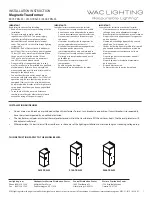
ABACOM Technologies
••
32 Blair Athol Crescent
•
Etobicoke
•
ON
•
M9A 1X5
•
Canada
•
Tel +416-236-3858
•
Fax +416-236-8866
•
3
A)
Helical
, fig. 4a: Wire coil, connected directly the antenna pin of the particular module and open circuit
at the other end. This antenna is very efficient given its small size (20mm x 4mm dia). The helical is a high
Q antenna, trimming the wire length or expanding the coil may be performed for optimum results. The
helical de-tunes badly with proximity to other conductive objects.
B)
Loop
, fig. 4b: A loop of PCB track tuned by a fixed or variable capacitor to ground at the ‘hot’ end and
fed from the antenna pin at a point 15 to 25% from the ground end. Loops have high immunity to proximity
de-tuning.
C)
Whip
, fig. 4c: This is a wire, rod, PCB track or combination connected directly the antenna pin of the
RF module. Optimum total length is 17cm (1/4 wave at 418 MHz) or 16.5cm (1/4 wave at 433.92MHz).
Keep the open circuit (hot) end well away from metal components to prevent serious de-tuning. Whips are
ground plane sensitive and will benefit from internal 1/4 wave earthen radial if the product is small and
plastic cased.
Antenna selection chart:
A
B
C
Helical
Loop
Whip
Ultimate performance
**
*
***
Ease of design setup
**
*
***
Size
***
**
*
Immunity to proximity effects
**
***
*
Fig 4.
The antenna choice and position directly controls the system range. Keep it clear (particularly the ‘hot’ end)
of other metal in the system particularly large ones like transformers, batteries and PCB tracks/ground
plane. The space around the antenna is as important as the antenna itself.,. The best position by far, is
sticking out the top of the product. This is often not desirable for practical/ergonomic reasons and a
compromise may be necessary.






















